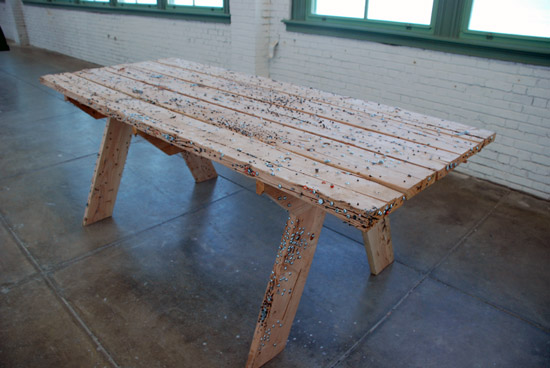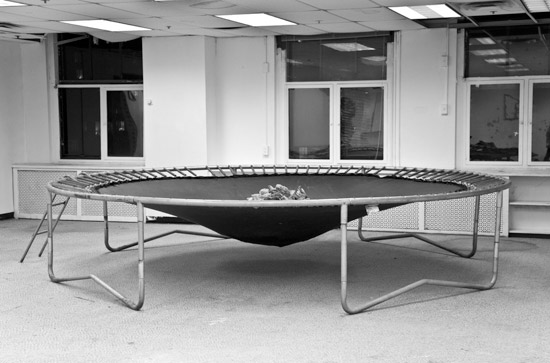
"603" (detail), 2010
While I was in Miami for art fair week earlier this month I had a chance to catch up with Brooklyn based artist Grayson Revoir, who was showing with West Street Gallery. Considering the thousands of artworks on display at the numerous fairs around Miami, Grayson’s exhibit was a welcome respite from the crowded booths. This is especially true considering where I saw it: his hotel room on the 6th floor of the Deauville – home to the NADA art fair. For those who may not be familiar with the artist, the recent Cooper Union graduate is perhaps most recognizable for his fusion of woodwork, found object and conceptual underpinnings. For his newest project he invited visitors to his guerrilla style art “booth” to carve, scratch, draw and otherwise impact the surface of a “picnic” table specially constructed on site for the fair. Both the interactivity of the piece and the context of its display formed a welcome contrast to the rest of NADA’s bustling 6 floors below. I met with Grayson serendipitously while foraging for food on the last day of the fair. Our interview was conducted as a result of a discussion we had while eating burritos on his sculpture.

At the Deauville, NADA 2010
Lets talk a little bit about your previous body of work. Your most recent piece is one of an entire series in which you utilize the picnic table for both sculptural and conceptual manipulation. Can you tell us a little bit about the motivation for this body of work?
It started when I did a show last year in the colonnade at Cooper Union. It’s a long and narrow space with lots of glass and rectangular columns with super dramatic light. When the building was built in the mid 19th century there was an entrance from the street and the space functioned as a walkway into the building. Now the entrance is defunct so people just hang out there and eat their lunch on these benches in between the columns. This feeling of passage is still implicit, yet awkwardly denied. The logic of the space is inherently narrative, so I wanted there to be a procession, a line, a parade. I called it SCULPTURECADE. The tables, five altogether, were each manipulated with an absurd or anthropomorphic condition. Their scale was determined by a figment of the picnic table, the length of the boards available at home depot, and the width of the colonnade..Each table was first built to play the role of a found object, then transfigured. It was important that each piece in SCULPTURECADE could be shown autonomously outside SCULPTURECADE. There were also two Egyptian Sarcophagus sculptures mixed in with the tables.
Why the picnic table?
They’re not really picnic tables. They just reference the form of picnic tables. They don’t have any benches and the dimensions are way off. But it’s good that everyone who looks at them sees them as a picnic tables, it’s the entrance point. They’re familiar with them because they eat, sleep, game, smoke, stretch, etc….on them. Picnic tables are generous, they don’t talk back, and they don’t complain. That’s how people know them. They’re modest public monuments that deserve exaltation. The idea with these tables, and working with ojects in general, is to impose conditions that thwart your organized perception of them. This makes you skeptical of the thing when you encounter it back in it’s natural habitat. The art gives new meaning to the ordinary thing. It’s a tall order.

"Picnic" 2010
How does this most recent work fit into the series?
In the initial series there is one table that’s treated with hundreds of carvings. I built the table in my studio and for three months, me and other people who were there did something to it. Like termites we set to feast on the table with knives, chisels, and whatever else we had to make a mark. It was finished when the whole table was covered in marks or carvings or inlaid objects. Even the legs. Someone took one of the legs away, said he wanted to work on it at home. When I got it back it was carved like a beaver gnaws at a tree to fell it. He “beavered” the leg of the table. It was wonderful because it exploited that action of carving your name in something out of desperation to be a part of it, and held up as a funny metaphor for sculpture. The most recent piece was carried out in the same way.
We discussed earlier, a final existence for this piece, in which the table’s surface could be mounted on the wall, do you have plans to do this?
Yeah, the intention for the piece was to go to Miami, get the wood, rearrange the furniture in the hotel room, build the table, then open the doors for people to come in and do something to it-whatever they want. After that the legs would come off and the surface of the table would be mounted on the wall horizontally. This time I want the focus to be on the top surface more so than the whole table. When it’s on the wall all the marks become diagrammatic like you get to read it like a painting, yet the idea of the picnic table still lurks.

"Tanning the Suburban Fantasy"
What prompted the decision to host your alternative installation at NADA?
The gallery who supported Room 603, West Street Gallery, is run by Matt Moravec and Alex Gartenfeld out of Alex’s apartment. The hotel room was a temporary continuation of working with that model; presenting art work in a domestic space because it’s what we have to work with.
West Street had a project booth in NADA where they showed Sam Falls. While they were down there, I was up in 603. People came up if they heard about it from us or the grapevine. Some people stayed, hung out and did something to the table, some people came in and left. You and I ate burritos on it. A different context always offers a different way to see the work. When you choose to present art in your hotel room or your apartment there’s always going to be a thick social layer, it’s never completely isolated. It made sense for me to take advantage of this by presenting a sculpture that’s a social monument, and would ultimately become a document, isolated on the wall.
What is your overall impression of this experience? Did you find the installation successful?
Yes! it was successful. Many people came up and did something to it, put some sort of impression on it. I need people to make it for me, or do most of the work on it. I just make the thing and allow a space to force feed that condition and history. A couple times I left people in the room. When I came back the thing had changed so much, it was satisfying. I never directed people, just allowed them to act on it.

"Mummy Bag" 2010
Overall thoughts on the fair?
It felt like navigating art on the Internet, clicking from gallery to gallery checking out who’s doing what. Personally, Art Basel is a mini city fit to flâneur. I had a good time doing that with my friends. The walls of the booths form an architecture that you have to navigate a certain way in order to correctly absorb the energy of all that work, which is a serious force. I found it easy to separate the work from the market. I know this seems impossible, but it’s actually easy if you think of the fair as a temporary museum. It got me exited about being a maker. I saw a lot of Cy Twombly paintings I’d never seen before, and maybe never would if I hadn’t gone. It’s like that, you know? Galleries bring their best work to sell, and just because it’s super marketable doesn’t mean it’s bad art. One of the first things I saw when I walked in through the modern entrance was a De Chirico painting! Then a huge Sigmar Polke! You have to be standing in front of these to understand how incredible they are, and the fair makes that accessible. Next year they should open the blinds on the glass mezzanine walk-way above the fair allowing people to observe the the gravel pit below. That would be beautiful.

 RSS
RSS
